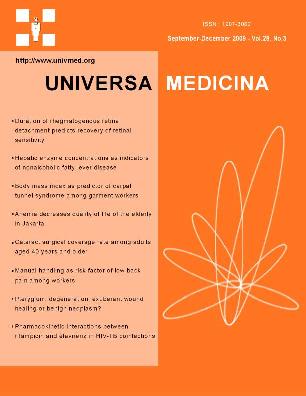Body mass index as predictor of carpal tunnel syndrome among garment workers
Main Article Content
Abstract
Article Details
Issue
Section
The journal allows the authors to hold the copyright without restrictions and allow the authors to retain publishing rights without restrictions.
How to Cite
References
Burke FD, Ellis J, McKenna H, Bradley MJ. Primary care management of carpal tunnel syndrome. J Postgrad Med 2003;79:433-7.
Kao SY. Carpal tunnel syndrome as an occupational disease. J Am Board Fam Pract 2003;16:533-42.
Sperka P, Cherry N, Burnham R, Beach J. Impact of compensation on work outcome of carpal tunnel syndrome. Occup Med 2008;58:490-95.
Alberta Employment, Immigration and Industry. Occupational injuries and diseases in Alberta. Lost time claims, disabling injury claims and claim rates. Edmonton, Alberta: Government of Alberta;2007.
Van Rijn RM, Huisstede BMA, Koes BW, Burdof A. Association between work related factors and the carpal tunnel syndrome - a systematic review. Scand J Work Environ Health 2009;35:19-36.
Phalen GS. The carpal tunnel syndrome: 17 years experience in diagnosis and treatment of 654 hands. J Bone Joint Surg Am 1966;48:211-28. Cited by Kao SY. Carpal tunnel syndrome as an occupational disease. J Am Board Fam Pract 2003;16:533-42.
Maghsoudipour M, Moghimi S, Dehghaan F, Rahimpanah A. Association of occupational and non occupational risk factors with the prevalence of work related carpal tunnel syndrome. J Occup Rehabil 2008;18:152-6.
Sastroasmoro S. Dasar-dasar metodologi penelitian klinis. Edisi 2. Jakarta: CV Agung Seto;2002.
World Health Organization. Appropriate body mass index for Asian populations and its implications for policy and intervention strategis. Lancet 2004;363; 157-63.
Katz JN, Simmons BP. Carpal tunnel syndrome. N Engl J Med 2002;346:1807-12.
Lajoie AS, McCabe SJ, Thomas B, Edgell SE. Determining the sensitivity and specificity of common diagnostic testa for carpal tunnel syndrome using latent class analysis. Plast Reconstr Surg 2005; 116:502-7.
Scanlon A, Maffei J. Carpal tunnel syndrome. J Neuroscience Nursing 2009;41:140-7.
Nathan PA, Isthvan JA, Meadows KD. A longitudinal study of predictors of research defined carpal tunnel syndrome in industrial workers: findings at 17 years. J Hand Surg 2005;30:593-8.
Wellman H, Davis L, Punnet L. Work related carpal tunnel syndrome (WR-CTS) in Massachusetts 1992-1997: source of WR-CTS, outcomes, and employer intervention practices. AM J Ind Med 2004;45:139-52.
Palmer KT, Harris C, Coggnon D. Carpal tunnel syndrome and its relation to occupation: a systematic literature review. Occup Med 2007;57: 57-66.
Stapleton MJ. Occupation and carpal tunnel syndrome. ANZ J Surg 2006;76:494-6.
Katz JN, Simmons BP. Carpal tunnel syndrome. N Engl J Med 2002;346:1807-11.
Gedizlioglu M, Arpaci E, Cevher D, Ce P, Kulan CA, Colak I, et al. Carpal tunnel syndrome in Turkish steel industry. Occup Med 2008;58:212-4.
Cole DC, Ibrahim S, Shannon HS. Predictors of work-related repetitive strain injuries in a population cohort. Am J Pub Health 2005;95;1233-7.
Werner RA, Franzblau A, Gell N, Ulin SS, Armstrong TJ. A longitudinal study of industrial and clerical workers: predictors of upper extremity tendonitis. J Occup Rehabil 2005;15:37-46.
Geoghegan JM, Clark DI, Bainbridge LC, Smith C, Hubbard R. Risk factors in carpal tunnel syndrome. J Hand Surg Eur Vol 2004;29:315-20.
Solomon DH, Katz JN, Bahn R, Mogun H, Avorn J. Nonoccupational risk factors for carpal tunnel syndrome. J Gen Intern Med 1999;14:310-4.
Ferry S, Hannafoed P, Warskyj M, Lewis M, Croft P. Carpal tunnel syndrome: A nested case-control study of risk factors in women. Am J Epidemiol 2000;151:566-74.
Toesca A, Pagnotta A, Zumbo A, Sadun R. Estrogen and progesterone receptors in carpal tunnel syndrome. Cell Biol Int 2008;32:75-9.


